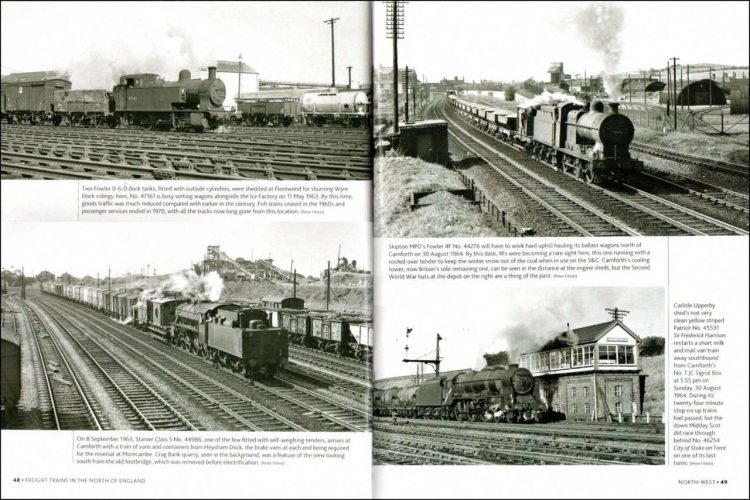This book provides a photographic appreciation of a great variety of freight trains, often-dirty and unloved, spanning sixty years from the mid-20th century.
Published in August 2020, this hardback book from publisher Pen & Sword and written by John Matthews, measures around 22.23 cm x 27.94 cm, has 144 pages, and 200 colour and black & white photographs. It has a published price of £25.00 although at the time of writing it can be obtained from Amazon for £18.56.
Against the background of a large reduction in the number of freight depots, marshalling yards, and sidings in recent years, this book reminds us of how things used to be. Often ancient goods engines struggled to get their trains moving, resulting in an explosion of steam and smoke as they struggled to get going. At other times, freight locos in superb condition were masters of their task.
The author has brought together the work of many outstanding railway photographers to display some of their best work from the mid-1950s right up to the present day. They include a great variety, from local trip workings with wooden wagons, long mixed goods trains, loose-coupled coal trains, block steel trains, and Speedlink services, hauled by a variety of steam, diesel, and electric traction.
Against the contrasting backgrounds of picturesque Northern landscapes and almost-forgotten industrial backdrops, this book superbly captures freight trains throughout the North of England.
The pages below neatly summarise the range of freight trains to be seen in the 1960s, with at the top-left an 0-6-0 tank engine on a trip working, whilst below that is a Stanier Class 5 running tender first on a trainload of vans and containers. The caption explains that the locomotive was running tender first, as it would soon run round its train. At the top-right below is an ex-LMS 4F 0-6-0 on a train of ballast wagons, which was once a common sight on the former London Midland Region, but because they were so common, photographers often neglected them. At the bottom right is a sight that became increasingly common towards the end of steam with Rebuilt Patriot Class 4-6-0 No. 45531 Sir Frederick Harrison hauling a short train of milk wagons.

Compared with the steam locomotives in the previous photos, the diesel locomotives below don't seem to give the same impression of power. They also reflect the change in freight traffic and the use of locomotives from steam days. At the top left, Class 45 45012, which is more suited to express passenger trains, is being used for shunting a couple of coal wagons. At the top-right is a sight that has become more common in recent years with a pair of diesel locomotives double-heading, in this case on a block train of cement wagons. At the bottom right is a pair of Class 20s hauling a heavy steel train.
Showing the typical dirty condition of steam locomotives in the mid-1960s are these views on the West Coast Main Line near Shap Summit. At the top-left, the photographer has captured a Crosti-boilered Standard Class 9F 2-10-0 from a vantage point that has now been swallowed up by the M6 Motorway. At the bottom-left Britannia Class No. 70054 Dornoch Firth has suffered the fate of many named locomotives at the end of steam by being stripped of its nameplates. The same fate seems to have been suffered by its classmate, No. 70018 Flying Dutchman, at the top-right as its great plume of smoke pays testimony to the locomotive's struggles climbing towards Shap Summit.
The photographs below again show freight trains struggling through the Cumbrian hills. At the top left a filthy LMS Jubilee Class 4-6-0 No. 45593 Kolhapur has lost its nameplate just like the previous Britannias. At the rear of the train can be seen a plume of smoke from a banking engine that came on at Tebay. The Britannia Class Pacifics photos on the right-hand page have both been shorn of their nameplates, with 70011 Hotspur at the top and 70024 Vulcan at the bottom, and although the photos were taken in 1967, just a few months before the end of steam, both locomotives seem to be well in control of their tasks.
Ancient and modern are seen below, with on the left a Class 92 electric locomotive hauling a block train of empty china clay slurry tanks, whilst at the bottom a Class 47 diesel locomotive hauling just two wagons on a Speedlink service shows how the demand for such services has declined when compared with the two photos on the right. Both photos show locomotives that were the mainstay of freight trains in the North-East, with an ex-London and North Eastern Railway Class J27 on a train of loaded coal hoppers, whilst at the bottom is an ex-War Department 2-8-0 in a typically grimy state at the head of a train of empty coal hoppers.
Although there are many photographic volumes illustrating railways from the steam age to the present day, it takes a very special offering to stand out from the rest. John Matthews' Freight Trains in the North of England is just one such book. The quality of the photography is excellent, the selection of photographs provides a great variety of images throughout the timescale of the book's coverage, all enhanced by superb reproduction on good quality paper. The captions provide just the right amount of information with details of the location, type of locomotive, and type of freight, and in most cases the train's origin and destination. The author has arranged the book in an anti-clockwise journey throughout the north of England from Derbyshire to the North-East, and has managed to include images of steam trains from the late-1960s when they were becoming an increasingly rare sight. An enjoyable read and very highly recommended.
The book is available to purchase from Amazon and from Pen & Sword.
We would like to thank Pen & Sword for providing RailAdvent with a copy of the book for review.